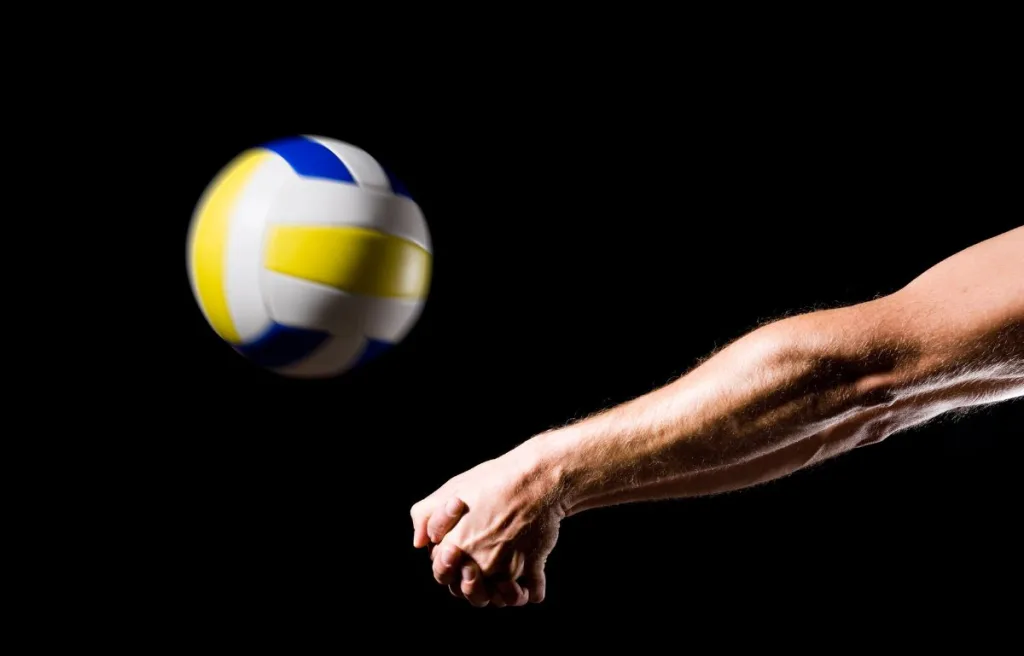What is an Ace in Volleyball? Serving Up Success!

You’re watching your favorite volleyball player on the court with the ball in hand and ready to go.
With a swift, powerful motion, he serves the ball over the net.

It streaks past the opposing team, untouched, and lands neatly on the other side.
Point scored!
Amid the excitement, you hear someone in the crowd exclaim, “That’s an ace!”
Hearing this, you start to wonder, what exactly is an ace in volleyball?
Key Takeaway: An ace in volleyball is a perfectly executed serve that results in an immediate point for the serving team.
It shows the server’s precision, accuracy, and control over the ball, resulting in one point for his team.
In this article, I will discuss what exactly counts as an ace, the strategies to improve it, and how the receiving team can avoid it.
What is Considered an Ace in Volleyball?
An ace in volleyball happens when the serving team gets an immediate one-point because the receiving team failed to handle it.
The most common type of ace is “no touch, “ meaning the ball hits the opponent’s court without any player touching it.
It is a skillful trick that gives your team an instant advantage and shifts the game’s momentum in your team’s favor.
It forces the opposing team to adjust the defensive formation, which increases your control over the competition.
Some people think that an ace is a position in volleyball, and they say that because of the famous Japanese manga series “Haikyu.”
In that series, some players call a pro volleyball player an “ace,” referring to him as the best offensive player on his team.
In reality, an ace is not a position in volleyball, and you may only find this term in the Japanese manga series.
Different Scenarios of an Ace
According to the NCAA, a serve that directly results in a point is considered an ace in volleyball.
So, there are mainly two types: the “no touch” ace, which is most common, and the other, known as a regular ace.
A ‘no-touch’ ace occurs when the serve reaches the opponent’s court without physical interaction.
Conversely, to understand the regular ace, let’s consider some scenarios:

The last point is a bit controversial as some experts believe it is not part of an ace.
But if you read the NCCA Volleyball Statistics guideline, they have mentioned that the out-of-rotation is also considered a type of ace.
If you are unaware of how the rotations work in volleyball, check out my dedicated guide to better understand this concept.
Serving Strategies for Aces
An ace gives an instant confidence boost to the serving team, providing them with a competitive edge.
However, it’s not a piece of cake as it requires practice and accuracy.
I am discussing 5 tips and tricks below to increase your chance of scoring an ace.
1) Target Weak Passers
One of the best and most common strategies to improve ace is to keep a keen eye on your competitors and find the weak spots.
You should properly analyze the opponent’s patterns and weak links in their receiving lineup.
It’s best to pinpoint the players struggling and having difficulty receiving the serve.
If you successfully aim your serve at those players, you can affect the opponent’s team coordination and increase your chance of increasing your ace count.
2) Be Unpredictable
Follow a different pattern for your serves, PERIOD!
I emphasize it because if you are predictable with how you do a serve, it is easier for the opponents to pick up your serve easily and throw it back.
So, there’s no chance of getting an ace.
Always try to target the edges of the court as it will make your serve almost impossible to receive.
However, the downside of this approach is that you need to be an expert in it to avoid losing more points.
Mix up your serves with speed, spin, and placement variations.
It confuses the opponents, forces errors at their end, and creates more opportunities for you to win aces.

3) Practice
We have heard this statement from childhood: “Practice makes a man perfect”.
Trust me, it is even more applicable if you want to excel at aces.
Devote time to make your serving techniques more accurate and consistent.
Experiment with different serve types, and take your teammates’ feedback.
Most importantly, focus on improving your control over the ball and practicing the perfect timing for maximum possibility of ace scoring.
The repetition and consistency during practice will help you to increase your confidence during an actual match.
Also, improve your vertical jump to give yourself an edge during an ace.
A higher jump enhances your serving power and increases your ability to handle powerful serves from opponents.
4) Serve Aggressively
Developing an aggressive mindset is crucial if you want to be pro at securing aces.
It doesn’t involve hitting the ball harder, but it’s more about controlled power and calculated risk to make your opponents uncomfortable.
Remember that winning an ace requires a certain level of risk-taking because you can lose the point if your aggressive serve misses the target.
But, if you take that risk and practice the ace, it can disrupt the opponent’s rhythm and create a sense of urgency at their end.
5) Find Substitute
It’s a clever approach to winning an ace.
But don’t get me wrong!
It is 100% legal.
You just have to be a keen observer of the game.
Target a substitute player who enters the game.
He may need more warm-up and game focus like his teammates.
Also, he has more chances of making errors.
You can target that substitute player as a server by delivering a challenging serve.
It’s a high chance of him committing the mistake and helping you to secure an ace.
Clever. Right?
Psychological Edge of Aces
Securing an ace adds an easy point to the scoreboard.
It also creates a fantastic psychological impact on the serving team throughout the lengthy volleyball match.
Let me discuss some further positive aspects of it:

How often do Aces occur in a Volleyball Match?
Aces occur more at high school, college, or university than at the professional level because of the difference in experience and skill set.
In lower-level matches, players are still refining their receiving skills, making it difficult to handle the aces.
As players progress to the professional level, their receiving skills become more polished, which helps them encounter powerful serves, resulting in a lower frequency of aces.
If you ask about the specific numbers, at the lower level, aces usually occur between 4-8 per set, and at a professional level, this number decreases to 2-4 per set.
Good Ace Percentage
The good ace percentage in volleyball for an average player is around 7%, which means out of all the serves he does during a match, around 7% could be an ace.
I took the above stats from the case study conducted by Gold Medal Squared, and according to them, this percentage increases to 8-9% for the good servers.
The goal of the server should be to score more than 9% of aces during the match.
How to Avoid Aces in Volleyball?
If you are on the receiving side of the court and facing the challenge of encountering an ace, I have compiled some practical strategies to help you better tackle the ace and improve the defense.
Legendary Ace Moments
Some incredible players pull off unbelievable aces in volleyball, almost like magic tricks.
These moments boost their team’s confidence and create unforgettable memories.
Let’s take a closer look at them.
1) Wilfredo Leon, the remarkable Cuban-Polish male outside hitter, scores 13 aces against Serbia during VNL 2021 and sets his team on track to success.
2) Yuji Nishida, a Japanese opposite hitter, destroys Canada during World Cup 2019 by scoring 6 aces in a row.
This fantastic control over the ball and the powerful serves helped Japan to win the critical match.
3) Ivan Zaytsev, an Italian volleyball player, succeeded in scoring 4 aces in a row against the USA.
His lightning-speed serves scared the opponents and helped his team win against the challenging competitor, the USA.
Final Thoughts
The ace in volleyball showcases a display of power and ball control by the server.
It leads to an immediate point, boosting the team’s morale, yet mastering this skill demands practice and dedication.
If you are on the defensive side and facing the challenge of an ace, vigilant observation of the server’s movement and practicing passing skills can help you tackle it confidently.
I wish you a victorious journey of aces!
